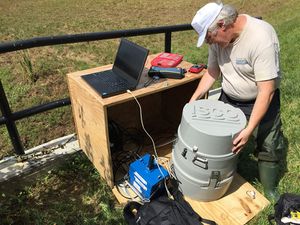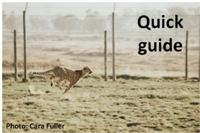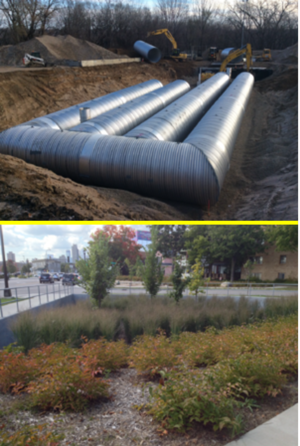
Recommendations and guidance for utilizing stormwater best management practice monitoring to meet TMDL permit requirements

Although BMP monitoring often refers to routine BMP infrastructure inspection and maintenance, in the context of this technical memorandum, BMP monitoring refers to monitoring flow volumes and pollutant loading into and out of an individual BMP to evaluate pollutant reduction effectiveness. Although performance of individual BMPs is typically estimated through modeling, calculated from design standards, or estimated using published literature values, MS4s may choose to monitor individual BMPs to more accurately evaluate BMP performance and track progress towards achieving target WLA reduction goals. Due to the cost and difficulty of individual BMP monitoring, BMP monitoring is typically considered only for large, regional BMPs where accurate calculation of BMP performance is critical to evaluating progress towards WLA reduction targets.
The following subsections outline the basics of developing a monitoring program for evaluating individual BMP performance and developing a monitoring protocol SOP. Specifically, the Establishing a Monitoring Program section provides guidance on when, where, and what to sample, while the Establishing a Monitoring Protocol section provides guidance on how to sample (i.e., sampling SOP).
Contents
Establishing a Monitoring Program
Before developing or implementing a BMP monitoring program, the applicable TMDL(s) should be reviewed to determine (a) if an ongoing water quality monitoring program is or will be implemented and (b) what organization(s) are responsible for water quality monitoring (e.g., individual MS4s, the applicable WMO, etc.). Review of ongoing and planned water quality monitoring programs can help an individual MS4 optimize sampling procedures to supplement ongoing monitoring efforts, and can help individual MS4s identify potential partnering opportunities with other organizations (e.g., WDs, WMOs, Universities, etc.).
In addition to review of planned or ongoing monitoring programs, the applicable TMDL(s) and drainage areas to major outfalls within the MS4 should be reviewed to determine the following information:
- TMDL review:
- What portion of the MS4 is included in the TMDL? The entire municipal boundary? A fraction of the MS4 area?
- How is the MS4 wasteload allocation (WLA) structured (e.g. required pounds of reduction per year (lbs/yr); required areal loading rate (lbs/acre/year); etc.)?
- MS4 BMP review:
- How many BMPs are within the MS4 TMDL watershed area?
- Are there large, regional BMPs (e.g., large ponds or lakes, large wetland areas, designed regional stormwater treatment facilities, etc.) within the MS4 TMDL area?
The steps outlined in the following subsections can be used to determine if BMP monitoring is a viable strategy for demonstrating WLA compliance, and, if so, how to develop a monitoring program to evaluate individual BMP performance.
BMP monitoring program feasibility
A critical first step to developing a BMP monitoring program is to evaluate the feasibility of individual BMP monitoring and whether or not individual BMP monitoring is a useful strategy for evaluating WLA compliance. Performance of individual BMPs is typically estimated through modeling, calculated from design standards, or estimated using published literature values. Due to the cost and difficulty of individual BMP monitoring, BMP monitoring is typically considered for implementation only for:
- Large, regional BMPs where accurate calculation of BMP performance is critical to evaluating progress towards WLA reduction targets;
- Calibrating water quality modeling;
- BMPs with a limited number of inlets and outlets (preferably, one inlet and one outlet);
- BMPs immediately tributary to the impaired waterbody or with no further downstream treatment (i.e., no other downstream, tributary BMPs); and
- Complex BMPs that cannot be estimated using published literature values or modeling results.
In addition to the BMP criteria listed above, the MS4 considering BMP monitoring implementation should first develop a scope of work to ensure sufficient resources are available (staff time, cost considerations, etc.). A detailed outline of how to develop a scope of work for a BMP monitoring program is included in the EPA’s Urban Stormwater BMP Performance Monitoring (EPA, 2002) guidance manual. As noted in the guidance manual, “Devoting large amounts of time and money to achieve a high level of accuracy may not be the best use of stormwater program resources. It might be more cost effective to spend less on trend monitoring and more on source identification, sediment monitoring, and/or other control measures.”
If BMP monitoring is not feasible, monitoring receiving waters and monitoring outfalls may be used by MS4s to evaluate WLA compliance and impairment status of receiving waters. For situations where BMP monitoring is feasible and may be critical to evaluating MS4 progress towards achieving WLA reduction targets, Link here for specific recommendations related to developing a BMP monitoring program.
BMP monitoring program recommendations
BMP monitoring can be used to directly evaluate WLA compliance for TMDLs developed based on mass (e.g, pound of TSS reduction per year; lbs/yr) or percent pollutant reduction. Developing an accurate estimate of pollutant reduction performance of the BMP requires simultaneous monitoring in inflow volume and pollutant concentrations entering and exiting the BMP. The following list outlines specific recommendations related to the development of a BMP monitoring program. Specific monitoring protocol recommendations are discussed here. BMP Monitoring Program Recommendations:
- Flow monitoring:
- Flow monitoring of all inlets and outlets is required (see feasibility discussion). Specific guidance related to flow monitoring strategies (e.g., using stage-flow relationships developed for inflow and outflow flumes) is discussed here.
- Pollutant monitoring:
- Pollutant monitoring of all inlets and outlets is required. Specific guidance related to the four pollutants highlighted in this memorandum (TSS, TP, bacteria, and chloride) is outlined in the modeling protocol discussed below.
- Monitoring period:
- Minimum: the seasonal duration used to define impairment for the given pollutant (e.g., April 1 through September 30 for TSS).
- Recommended: year-round monitoring if possible. If freezing occurs at monitoring station, monitor April through November.
- Monitoring frequency:
- Minimum: specific guidance related to determining the number of storm events to sample and number of samples to collect per storm event discussed in the monitoring protocol.
- Recommended: Continual monitoring using continuous flow loggers and automatic or in situ sampling.
- Sampling protocol: link here.
Establishing Monitoring Protocol
The MPCA has specific requirements and protocols related to water quality data collection, laboratory processing of water quality samples, data processing of laboratory results, and final submittal of water quality data to the MPCA for review. Specifically, the MPCA uses a data processing system called EQuIS (Environmental Quality Information System) to store and process water quality data collected from over 17,000 sampling location across the state, and requires that data be collected and processed in a manner which is compatible with EQuIS. A detailed description of the EQuIS system, including preparation of field monitoring results for submittal to the MCPA is presented here.
The EPA has developed a BMP monitoring guidance document (Urban Stormwater BMP Performance Monitoring; EPA, 2002), which provides detailed instruction, information, and guidance related to (a) development of scope and objectives for a BMP monitoring program, (b) developing a BMP monitoring plan, (c) implementation of a BMP monitoring plan, and (d) evaluation and reporting or results. Because information in the EPA guidance document was not developed specifically for Minnesota, State-specific post-sampling procedures (e.g., chain of custody (COC) procedures for delivering samples to MPCA certified laboratories) outlined in the Standard Operation Procedures: Intensive Watershed Monitoring – Stream Water Quality Component (MPCA, 2018d) should be incorporated into the BMP monitoring protocol.
In addition to the EPA guidance document (EPA, 2002) and the general stream monitoring SOP (MPCA, 2018d), one additional outfall monitoring guidance document is discussed below: the UMN Optimizing Stormwater Treatment Practices (Erickson et al, 2013). Although portions of this document are reference guidance presented in the EPA guidance document discussed above (EPA, 2002), this document provides additional guidance related to monitoring specific BMP types, and includes a detailed discussion of routine maintenance and inspection procedures.
It is recommended that the documents discussed in this section be used in conjunction with specific monitoring guidance outlined in the applicable TMDL when developing a BMP monitoring SOP.
For a case study of BMP monitoring, link here.
Additional Resources
- Optimizing Stormwater Treatment Practices (Erickson et al, 2013): although portions of this document reference and are based on the EPA guidance document (EPA, 2002), this document provides additional information regarding monitoring of specific BMP practices (e.g., filtration practices). Additionally, this document provides detailed guidance and instruction on developing a routine BMP inspection and maintenance program, including a detailed SOP with recording forms for level 1 visual inspections.
Related pages
TMDL MS4 permit guidance
- Forms, guidance, and resources for completing the TMDL annual report form
- Chloride
- Guidance for meeting bacteria TMDL MS4 permit requirements
- Guidance for meeting dissolved oxygen or oxygen demand TMDL MS4 permit requirements
- Guidance for meeting temperature TMDL MS4 permit requirements
- nitrogen
- Summary of TMDL requirements in stormwater permits
TMDL toolkit for MS4 permit compliance

- Overview of models used to meet MS4 TMDL permit requirements
- Recommendations and guidance for utilizing P8 to meet TMDL permit requirements
- Recommendations and guidance for utilizing WINSLAMM to meet TMDL permit requirements
- Recommendations and guidance for utilizing the MIDS calculator to meet TMDL permit requirements
- Recommendations and guidance for utilizing the MPCA Simple Estimator to meet TMDL permit requirements
- Recommendations and guidance for utilizing monitoring to meet TMDL permit requirements
- Recommendations and guidance for utilizing lake monitoring to meet TMDL permit requirements
- Recommendations and guidance for utilizing stream monitoring to meet TMDL permit requirements
- Recommendations and guidance for utilizing major stormwater outfall monitoring to meet TMDL permit requirements
- Recommendations and guidance for utilizing stormwater best management practice monitoring to meet TMDL permit requirements
- Quick guides for using models to meet MS4 TMDL permit requirements
- Case studies for monitoring to meet TMDL permit requirements
TMDL guidance and general information
- Overview of TMDLs
- Addressing TMDL Requirements in MS4 General Permit Applications and Stormwater Pollution Prevention Program Documents
- List of approved TMDLs with MS4 Wasteload Allocations
- Technical guidance used by MPCA to develop guidelines for setting TMDL WLAs for regulated stormwater
- Case studies for regulated stormwater issues
- Guidance on what discharges should be included in the TMDL wasteload allocation for MS4 stormwater
- File:Guidance on What Discharges Should be Included in the TMDL Wasteload Allocation for MS4 Stormwater.docx - August 2010
- Construction activity by county
This page was last edited on 14 February 2023, at 19:26.
